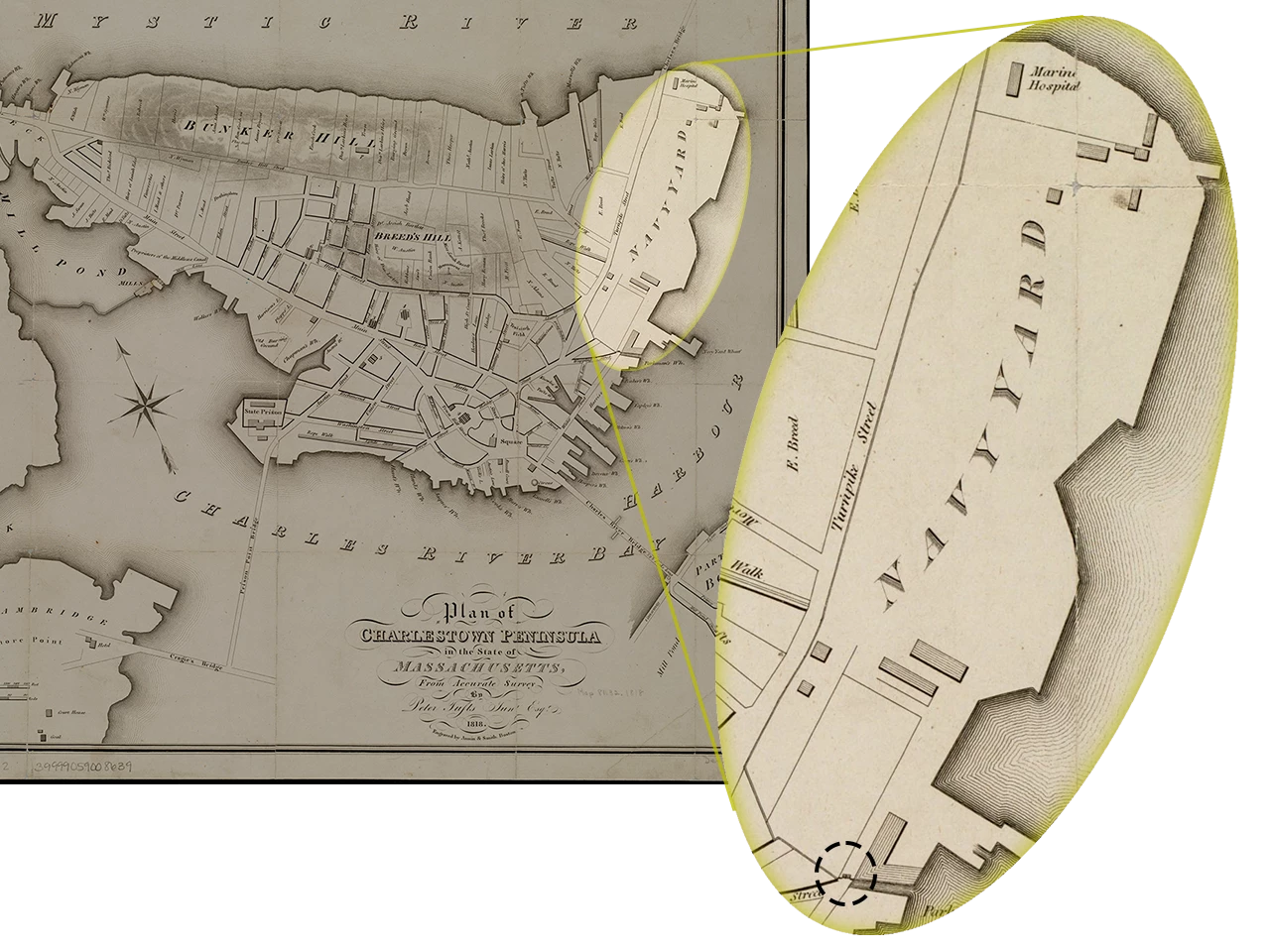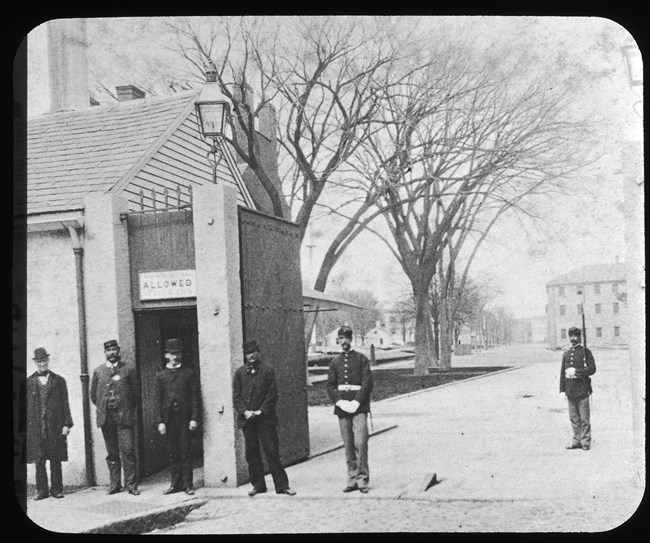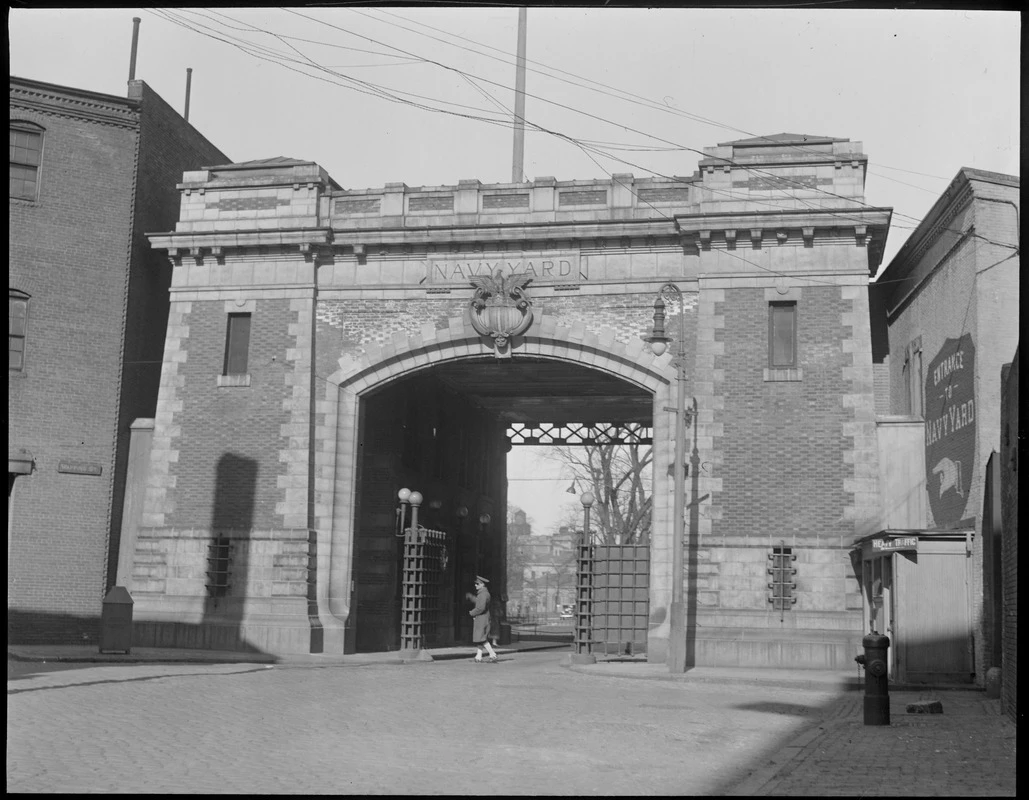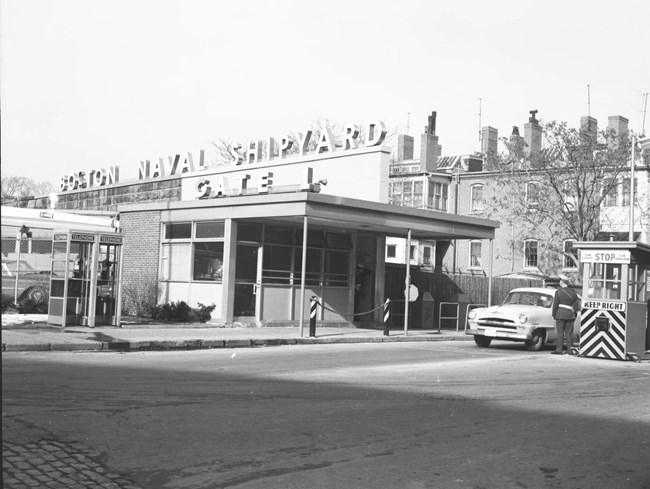Last updated: January 8, 2025
Article
Charlestown Navy Yard: Gate 1
What makes a navy yard a yard?
In the case of the Charlestown Navy Yard, the process began with the federal purchase of land that faced Boston Harbor, between the Charles and Mystic rivers, in 1800. The Navy set up barriers and hired guards. However, during this early period the yard in Charlestown saw very little use beyond a place to store lumber and other materials for the Navy's new warships, including USS Constitution.
Eventually, fencing encompassed the yard, and a number of gates were established to control outside access. The Marine Corps, reestablished in 1798 to serve as a constabulary and fighting force aboard warships, also took on the duties of guarding navy yards. These entry points, guarded by US Marines, became the public face of the Charlestown Navy Yard for the next two centuries.

Courtesy Norman B. Leventhal Map Center/Boston Public Library

Photograph by A.E. Alden; Charlestown Lantern Slides collection, Boston Public Library
Gate 1, originally a simple wooden sentry box and a picket fence, was one of the earliest guarded entries to the yard and it served as the main entry for visitors. As such, Gate 1 held a symbolic as well as a practical purpose. Facing the public, Gate 1 was often the first place that someone coming into the yard experienced.
As the yard grew, so too did the importance of the gate in terms of prestige and security. Construction of new ships and the repair and refit of old ones meant there was a serious reason to keep unwanted visitors out. Yet those same ships also drew important guests to the Yard to witness their launch or commissioning in the Navy.
Iron bars replaced the simple wooden fence in 1847, and in 1901 Gate 1 was reconstructed as a granite and brick gatehouse in the Beaux-Arts style. This castle-like structure was used by the Marines not only as a gatehouse but also as a living quarters, and it represented the increasing focus of making the United States a global naval power.

Courtesy Boston Public Library, Leslie Jones Collection
This visually impressive entrance to the Navy Yard echoed the US Navy's growth as a global power at the time. As the American “Great White Fleet” circled the globe representing American naval power abroad, gates such as this one echoed that power at home.
Gate 1, however, was not the primary entrance for most workers and supplies in the early 1900s. Many workers entered via the pedestrian entrances on Chelsea Street where public transportation was more readily accessible. Other workers came by boat from elsewhere in Boston Harbor. Supplies and goods too came in by ship and boat as well as by rail on tracks that entered the Navy Yard to the southeast of Gate 1.
After World War II, gate usage shifted again. The total number of workers at the Yard paled in comparison to wartime numbers, but increasingly more and more of these workers arrived by personal automobile. The construction of the Tobin Bridge and other highways made commuting in by car form convenient, but it brought increased congestion and presented serious parking issues.
The increasing automobile traffic ultimately led to the demolition of the ornate gatehouse. During the 1950s, workers grew more reliant on larger trucks to transport heavy and oversized goods. The trucks could not easily navigate the narrow arched opening. The Navy decided the most practical solution was to replace the gate.

Boston National Historical Park, BOSTS 8947-1631
This new Gate 1, which still greets visitors to the yard today, allowed for two-way traffic and featured clean, modern, contemporary 1950s architecture that incorporated a greater use of steel and glass.
While somewhat mismatched to the older buildings and architectural styles, Gate 1 represents the yard as a space in a constant state of change, one that is required to both uphold tradition and meet practical requirements.
Although no longer guarded by Marines, Gate 1 continues to serve much of the same purpose it did in the 1800s. It still greets visitors and clearly marks where the outside world ends and the navy yard begins.
Sources
Bearss, Edwin C. Historic Resource Study: Charlestown Navy Yard, 1800-1842, Volume II. Boston, Massachusetts: Boston National Historical Park, National Park Service, U.S. Department of the Interior, October, 1984.
Bearss, Edwin C. and Frederick R. Black. The Charlestown Navy Yard 1842-1890. Boston, Massachusetts: Boston National Historical Park, National Park Service, U.S. Department of the Interior, July 1993.
Black, Frederick R.. Charlestown Navy Yard: 1890-1973, Volume I and Volume II. Boston, Massachusetts: Division of Cultural Resources, Boston National Historical Park, National Park Service, U.S. Department of the Interior, 1988.
Carlson, Stephen P. Charlestown Navy Yard Historic Resource Study, Vol 1-3. Boston, MA: Division of Cultural Resources Boston National Historical Park National Park Service U.S. Department of the Interior, 2010.
